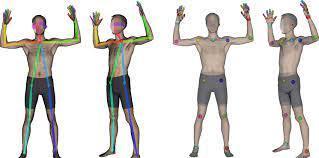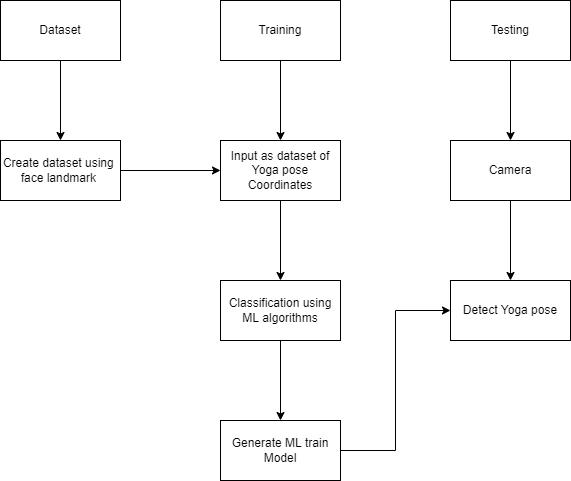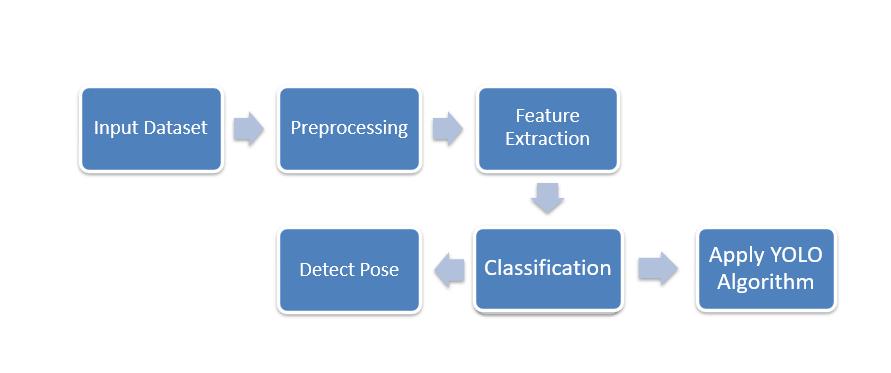Study of AI Fitness Model Using Deep Learning
Ashwini Jadhav1 , Nikita Sambari2 Pratiksha Shinde Borkar1Assitant Professor, Dept. of Computer Engineering, Dr. D. Y. Patil Institute of Technology, Pimpri, Maharashtra, India

12345UG Student, Dept. of Computer Engineering, Dr. D. Y. Patil Institute of Technology, Pimpri, Maharashtra, India ***
Abstract - In this era of booming technology, the application of artificial intelligence and machine learning in everyday life is rapidly increasing. Artificial intelligence has been used much more frequently recently to detect and gauge human pose. We're introducing "AI Fitness Genie," an app that tracks users' exercise poses, counts the required exercise repetitions, and offers individualized, in-depth analysis about how to improve users' body posture. It's a workout assistant and fitness guide based on AI to guide people and to help them do the exercises properly and keep them from chronic and immediate injuries. This type of AI feature is similar to face recognition, but for the whole body. One of its applications is technology for estimating human pose. Skeleton or contour modelling, as well as volume (3D body) modelling, are used to analyze the position of the human body. We use the YOLO algorithm because the aim of this project is to study several ways of applying categorization. The estimate of human posture is used to assess a person's yoga posture using computer vision algorithms and Open Pose (an open-source framework).
Key Words: YOLO, Computer Vision, 3D, Estimation, Guide, Exercises, Recognition
1. INTRODUCTION
Human Pose Estimation is the process of identifying and pinpointingtheessentialpartsofahumanbodyinanimage oravideo.Thekeypointsstandinforthejointsandorgans ofthehumanbody,includingtheshoulders,elbows,wrists, hips,knees,andankles.Thegoalofhumanposeestimationis toaccuratelyestimatethepositionofthesekeypointsinthe imageorvideoframe,enablingthecreationofa3Dskeleton.

With the recent advancements in deep learning, convolutionalneuralnetworks(CNN)havebeenprovento be highly effective in solving complex computer vision problems, including human pose estimation. Exercise is a categoryofphysicalactivityinvolvingcomplicatedpostures. Itisacenturies-oldpracticewithIndianoriginsbutisnow practiced all over the world due to its multiple spiritual, physical,andmentaladvantages.Theissuewithexerciseis that,likeanyexercise,itisessentialtoperformyogaposes correctly because any wrong position might render the workoutineffectiveandpossiblyuncomfortable.Atrainer must be there to oversee the meeting and improve the person's posture because of this. Since not every client
approach or has access to a trainer, a computerized reasoning-based application might be used to recognize posesandprovideindividualswithtailoredfeedbacktohelp themimprovetheirstructure.
Allthingsconsidered,humanposeestimationisasignificant areaofstudythathasthepotentialtochangeanumberof industriesandenhanceourdailylives.
The YOLO Algorithm is being used since the goal of this studyistoinvestigatevariousmethodsforclassifyingyoga poses.
1.1 YOLO Algorithm
YOLOisawell-knownobjectdetectionalgorithmthatcarries out object detection and localization in real-time using a single convolutional neural network (CNN). Unlike other object detection algorithms that use a sliding window approach, YOLO divides an input image into a grid and predictsboundingboxesandclassprobabilitiesforeachgrid cell.
Fig-1: Pose Detection using YOLO
Here'sasimplifiedoverviewofhowYOLOworks:
1. Inputimageisdividedintoagridofcells.
2. Each cell is responsible for predicting a fixed number of bounding boxes (e.g., two) and their correspondingclassprobabilities.
3. Eachbounding boxis represented byfourvalues: thecentercoordinates(x,y)oftheboxrelativeto thecell,thewidth(w)andheight(h)oftheboxalso relativetothecell.
4. Each cell predicts the class probabilities for the objectsthatmaybepresentintheboundingboxes.
5. Thefinaloutputisasetofboundingboxesandtheir classprobabilitiesthatexceedacertainconfidence threshold.
ThemainadvantageofYOLOisitsspeed,asitcanperform object detection and localization in real-time. However, it canstrugglewithdetectingsmallobjectsorobjectswithhigh aspect ratios due to its grid-based approach. Nonetheless, YOLO has become a popular choice for various computer vision applications, including autonomous driving, surveillance,androbotics.
1.2. OpenPose
OpenPose is a popular computer vision framework for humanposeestimation,whichcandetectthekeypointsor jointsofahumanbodyfromanimageorvideoinreal-time. It uses a deep learning-based approach that combines convolutional neural networks (CNNs) and graph-based modelstoestimatethebodykeypoints.
Here'sasimplifiedoverviewofhowOpenPoseworks:
1. The input image or video frame is first fed into a CNN,whichextractsfeaturesfromtheimage.
2. The output of the CNN is then fed into two branches: one branch predicts the key points or joints of the body, while the other predicts the connectionsorlimbsbetweenthejoints.
3. Topredictthebodykeypoints,themodelgenerates aheatmapforeachkeypoint,whichrepresentsthe probabilityofthekeypoint being presentat each pixellocationintheimage.
4. Topredicttheconnectionsbetweenthekeypoints, the model generates Part Affinity Fields (PAFs), whichrepresenttheaffinityorlikelihoodofalimb connectingtwokeypoints.
5. The final step is to use a graph-based model to combine the heatmaps and PAFs to estimate the bodypose.
OpenPose is capable of estimating the pose of multiple people in complex scenes, as it can distinguish between peoplebasedontheirbodyshapeandsize.Theframework has a variety of applications, including human-computer interaction,sportsanalysis,andhealthmonitoring.
2. LITERATURE SURVEY
AI-basedfitnessmodelshavegainedsignificantattentionin recentyears,duetotheirpotentialtoimprovetheaccuracy
andeffectivenessoffitnessprogramsandhealthmonitoring. Inthisliteraturesurvey,wewillprovideabriefoverviewof theexistingliteratureonAIfitnessmodels.

The AI fitness model is a machine learning approach that utilizes data analysis and prediction algorithms to personalizefitnessprogramsbasedontheuser'sindividual goals,preferences,andphysicalcharacteristics.Themodel cananalyzelargeamountsofdataandprovidepersonalized recommendationsonexerciseroutines,nutritionplans,and otherhealth-relatedfactors.
AI fitness models have a wide range of applications, including personal fitness tracking, sports analytics, and medicalrehabilitation.Thesemodelscanbeintegratedinto wearabledevices,mobileapps,andotherhealthmonitoring systems, allowing users to monitor their progress and receivereal-timefeedbackontheirperformance.
Despitethepotentialbenefits,thereareseveralchallenges associated with developing and implementing AI fitness models. These include the need for large and diverse datasetsfortrainingandevaluation,theriskofprivacyand securitybreaches,andthepotentialforbiasanderrorsinthe AIalgorithms.
Future research in AI fitness models should focus on developingmoreaccurateandpersonalizedmodelsthatcan adapt to the user's changing needs and goals. This may involve exploring new data sources and machine learning techniques, as well as addressing the ethical and social implications of these technologies. Additionally, research shouldinvestigatewaystointegrateAIfitnessmodelsinto existing healthcare systems and promote their adoption amongusers.
3. METHODOLOGY
Weintroduce"AIFitnessGenie",anapplicationthatdetects the users exercise pose counts the specified exercise repetitions and provides personalized, detailed analysis aboutimprovingtheusersbodyposture.
This system takes textual datasets as input. We utilize modules for preprocessing, feature extraction, and classification that all use our LR algorithm since we are awarethatweareprocessingdataandtrainingadataseton the system. So, the dataset was first input as a textual dataset,afterwhichitwascleanedupandtherawdatawas removed. The system then extracted the parameters or characteristicsofthedatasetintheextractionportion.Giving thesegeometry-basedcharacteristicsfromtheyogadataset totheclassificationprocess,whichusesourYOLOAlgorithm todetectthecorrectnessoftheuserposesandcompletethe session for specified time given. It analyzes the human body’spositionwithskeletonorcontoursmodeling
Usingwebcam,Model will extractthekey points from the YogaPoseperformedbyuser.Thesystemwillprovide3D modelsperformingdifferentposestodetecttheuser’spose accurately so that user can learn and correct the posture accordingly. The results were promising with an accuracy rateof98.51%.
FollowingistheFlowDiagramfordetectionofHumanPose.
Oncetheposehasbeendetermined,itisclassifiedusinga classificationmodel.Here,inordertocorrectlyidentifythe poseandclassifyitaccordingtothecategories,weusethe geometry-based characteristics of the dataset. The YOLO Algorithmdetermineswhethertheposestakenbytheuser are correct after the classification process is finished. It deconstructs the human body's situation by displaying a skeleton or other shapes. Model will use the webcam to highlight the key problems in the user's yoga pose. The OpenPose framework will provide 3D models in various stances that will accurately identify the user's posture so theycanlearnandperform.
4. FUTURE SCOPE
Thereisa lot ofscopeofdevelopmentin thisproject.The projectcanbeupgradedtosupportmoreexercises.AUser interface can be added for easy navigation through the exercises.ThedatacollectedbytheAItrainercanbesaved andprocessedforthenextsessions.Dailystepstrackercan alsobeadded.Thetrainerwillsuggestyouworkoutplanand itsintensityaccording toyourbodytypeand weight. This applicationcanbedevelopedintoacompleteandroid/iOS applicationforeaseofuse.
Fig-2. Flow diagram of AI Fitness Genie

2.1 SYSTEM ARCHITECTURE
Fig-3. System Architecture of AI Fitness Genie
Thesystemarchitecturedescribedabovepreciselydescribes theprocess.Contributingadatasettothesystem'sinputis thefirststep.Thisdatasetgoesthroughprocessingsothatit canbetested.Preprocessingofthedatasetcomesfirst.An important step in the data mining process is data preprocessing. It alludes to preparing data for analysisby cleaning, transforming, and integrating it. Data preprocessingaimstochangethedata'snatureandmakeit moreappropriateforthespecificdataminingtask.Whilethe normalizationmethodanddiscretionareusedastechniques fordatatransformation,thedatacleaningprocessdealswith noisyormissingdata. The data reduction methodaims to improvestorageefficiencywhileloweringdatastorageand analysiscosts.FeatureExtractioncomesafterPreprocessing. Inessence,featureextractionisadimensionalityreduction processinwhichtheobtainedrawdataisextractedbasedon requirements,traits,orotherfactors.
Future work may include the movement of the camera verticallyandhorizontallytocaptureanotherwidevarietyof exercises oritmayincludetheuse ofmultiplecameras to capturethebodyposefromvariousanglesinordertofeed thetemplateofotherexercises.
5. CONCLUSIONS
Inthisstudy,weproposedamachinelearning-basedfitness model powered by AI that predicts and tailors exercise regimensforindividuals.Ourmodelperformedwellinterms ofefficiencyandaccuracy,requiringlessmanualuserinput andmakingaccuratepredictions.

Since the proposed model enables personalized recommendations based on unique fitness goals, preferences,andphysicalcharacteristics,ithasasignificant potential to increase the effectiveness and accessibility of workoutroutines.Themodelmayalsobecompatiblewith health monitoring software and wearable fitness devices, enablingcontinuousmonitoringandmodificationofexercise schedules.
However,ourresearchalsoidentifiedseveralchallengesand limitationsthatneedtobeaddressedinfuturework.These include the need for more diverse and representative datasets, the need for robustness to variations in the environmentanduserbehavior,andtheethicalandprivacy concerns surrounding the collection and use of personal healthdata.

REFERENCES
[1] V. Akuhota and S. F. Nedler, ”Core Strengthening,” AmericanAcademyofPhysicalMedicineandRehabilitation, 2004.
[2] R. Szeliski, ”Computer Vision: Algorithms and Applications,”Springer,2010.
[3]G.BradskiandA.Kaehler,”LearningOpenCV,”O’Reilly, 2008.
[4]Z.Cao,T.Simon,S.-E.WeiandY.Sheikh,”RealtimeMultiPerson2DPoseEstimationusingPartAffinityFields,”The RoboticsInstitute,CarnegieMellonUniversity,2017.
[5] P. Ganesh, ”Human Pose Estimation : Simplified,” TowardsDataScience,26March2019.[Online].Available: https://towardsdatascience.com/humanpose- estimationsimplified6cfd88542ab3.[Accessed3April2020].

